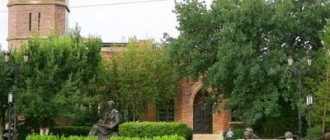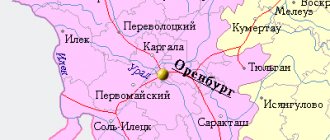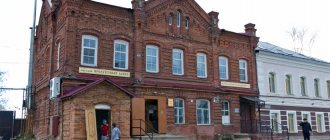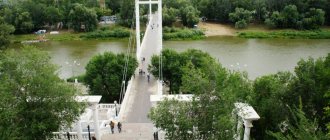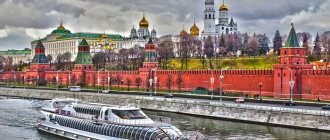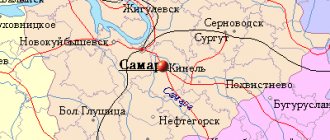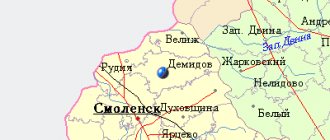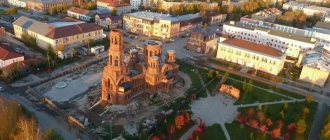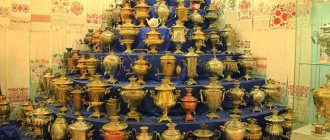Foundation of the city
This settlement was not formed spontaneously, like most settlements in Russia. The idea to build a city came to the mind of the Kazakh Khan. He promised Queen Anastasia to protect the integrity of the lands, protect the borders from attacks and help merchants if in return they built a fortress that would serve as a shelter in case of danger.
This is where the history of the city of Orenburg begins. On August 31, 1735, the first stone was laid for the construction of a large and reliable fortress. This building is located at the confluence of the Or and Yaik rivers.
A funny situation happened with the choice of place. The first expedition led by I. Kirillov identified the ideal location. However, after his death, V. Tatishchev moved the construction site downstream of the Yaik. And again a miss, as the terrain turned out to be rocky and far from the river.
And only in 1739 the final version was determined and approved - the former Berd fortress. The history of Orenburg began, and the city was nicknamed thrice conceived and once born.
Why is the city so named: Orenburg, the capital of the Orenburg region
Orenburg was founded on April 19 (April 30), 1743. The first fortress was founded on August 31, 1735 on the site of Orsk, where the name of Orenburg came from - “fortress on the Or River.” The original location for the city was chosen during the expedition of the initiator of the development of the region, I.K. Kirillov. After the death of I.K. Kirillov, V.N. Tatishchev was appointed head of the Orenburg Commission. It seemed to him that the place was too inconvenient, and besides, it was flooded by spring floods. In 1739, preparations began for the construction of a city near a place called Krasnogor (Red Hill) and on August 6, 1741 it was founded. However, construction of the city did not begin. The new head of the commission, Rear Admiral and Privy Councilor I. I. Neplyuev, who arrived at his place of duty in the spring of 1742, found the location of the city near Red Mountain unsuitable, and in the summer of 1742 he chose where the historical center of Orenburg is now located. The choice of place turned out to be successful, as the first Orenburg governor I. I. Neplyuev put it this way: “Of all the places in Yaik, the best arable farming is found here” and “The arrival of Russian merchants will be closer.” Orenburg was built according to a clear plan, with German precision in planning. The city government was organized in the German manner. “So that the inhabitants and visitors of that city are in all order and well-being and contentment and have a fair trial and punishment, for this reason we determine that the Magistrate will be among the three Burgomasters and six Ratzgers, and that the court will be established...” wrote Anna in “Privilege.” More than two and a half centuries later, Orenburg remains the administrative and economic center of a vast territory.
It was built as a fortress city, as a stronghold of the lines of fortresses along Yaik, Samara and Sakmara, guarding the south-eastern border of Russia; At the same time, the city was supposed to serve as a center of economic communication with the peoples of the east, which, first of all, implied trade. Therefore, the city had both a military and commercial character: there were barracks, an artillery yard, powder magazines, military institutions, living and exchange yards, and customs. From October 5, 1773 to March 23, 1774, the city was besieged by the army of Emelyan Pugachev.
In 1920, Orenburg became the first capital of Kazakhstan (Kyrgyz ASSR). The city as a capital did not last long; since 1925, the capital of Kazakhstan was moved to the city of Kzyl-Orda (now Kyzylorda), and the city itself was included in the Russian Federation. In December 1934 it became the center of the Orenburg region.
In the period from 1938 to 1957, the city bore the name Chkalov, in honor of the famous Soviet pilot Valery Chkalov,
There are different versions about the name of the city. According to P.I. Rychkov, the word Orenburg is derived from the name of the Or River, which flows into the Urals three hundred kilometers from the current location of the city. There is another city there - Orsk, which Anna Ioannovna originally ordered to be designated Orenburg.
It has been noted that cities ending in “burg” occupy a special position on the map of Russia - they are geographical, administrative, and economic centers (for example, St. Petersburg, Yekaterinburg). This fate was destined for Orenburg, and therefore it was impossible to abandon the beautiful and sonorous name of the secondary fortress (“burg” translated from German is nothing more than a fortress, a castle). They named it Orsk. The designation Ori in the name of the capital of the region was retained, although this small river is quite far from Orenburg - at that time it took a week to get to it. Local historian V.V. Dorofeev gives his version of the origin of the name of the city. He takes into account the significant influence of foreigners during the reign of Anna Ioannovna. "Ohren" means "ears" in German: "fortress-ears". Most likely, both assumptions are correct: having received the name from the river, the name then acquired a second meaning.
Origin of the name
The origin of the name of the place becomes clear to anyone who has delved even a little into the geography of Russia, especially the Orenburg region. Everyone immediately associates it with the Or River and the part “burg”, which in German means “city”. Literally, the name, based on this concept, is translated as “hail on Ori”. There is an opinion that I. Kirillov gave this name to the newly built settlement. He also sent a package of relevant nomination documents to Empress Anastasia.
Also, the history of Orenburg does not allow us to discard the version that the name came from the Kazakh “orybor”.
It is worth noting that due to misunderstandings with the location of the fortress, this name was long borne by the first fortress founded by Kirillov. However, over time, the empress issued a decree in which the right to be called Orenburg was assigned only to the place that still bears this name.
Since 1938, the city was renamed Chkalov, in honor of the famous pilot. By the way, the latter had nothing to do with this area. In 1957, the settlement again received its historical name.
Report to the project
My hometown is Orenburg. This is a wonderful and very beautiful city, which stands on the Ural River, in the southern Urals. Unofficially, the Ural River divides Orenburg into European and Asian parts. However, modern geographers do not consider the Urals to be the border between Europe and Asia.
History and symbols
On the flag and coat of arms we see the image of a double-headed eagle, donated to Orenburg by Empress Catherine the Great, as well as the blue ribbon of the Ural River and St. Andrew's Cross, as a sign of fidelity to the Russian state.
The name Orenburg comes from the name of the Or River, at the confluence of which with the Urals the fortress was originally founded in 1734. But soon the fortress was moved to another place, where Orenburg is now located. The official year of its foundation is considered to be 1743.
It initially played the role of a supporting fortress on the southern borders of the empire. He was besieged by Pugachev’s troops, and he also played a role during the Civil War.
Modern Orenburg
Now it is a beautiful and modern city, with developed industry, and a large cultural and scientific center. More than 500 thousand people live here.
We have many beautiful streets, modern avenues and wide squares. Sovetskaya Street, the main tourist center of Orenburg, its “Arbat” is considered a special pride of the residents.
Attractions
The city has many beautiful and majestic churches and interesting monuments. Among which there is even a monument to Peter the Great, although the city was founded after the death of the first emperor.
We have many museums: local history, art, history of Orenburg. The oldest drama theater was founded in 1869.
We have many beautiful parks and squares, where it is very pleasant to stroll both on a hot summer day and in cold winters.
Memorable places of military glory
During the Great Patriotic War, Orenburg became one of the evacuation centers. Refugees from the European part of the country moved here, industrial enterprises were brought here, which laid the foundation for the economic development of the city.
Therefore, we sacredly honor the memory of the heroes of the Great Patriotic War. On Victory Avenue there is a memorial complex with a huge stele, granite slabs with carved names of soldiers, and the Eternal Flame.
Conclusion: why I love my city Orenburg
My city is one of the best in the world, and I love it very much. I love its streets and avenues, its parks and squares, the best monuments in the world. I love its architecture and its people.
I wish my city to become even better, more beautiful and cleaner. So that only kind and good people live in it.
First decades of life
The history of Orenburg, or rather, the territory of the modern city and region, changed dramatically after the construction of the fortress. Residents of other Russian regions began to occupy the region of nomads. And next to this fortification, dozens of defensive structures were erected, ditches were dug and high walls were built.
Initially, soldiers were moved here in the hope that they would start farming. But the history of the city of Orenburg indicates the opposite - the warriors, unencumbered by relatives, did not demand much, therefore they had no desire to get rich and get hold of a household.
Then it was decided to create Cossack irregular troops, where even fugitives were accepted. Peasants began to develop the virgin steppe lands.
However, there were not so many artisans. The city grew and strengthened thanks to trade and over time became a powerful center, which along with the surrounding lands turned into the Orenburg province.
World War I
In July 1917, the Alash party was formed, which discussed issues of governance and power. Representatives were delegated from it to the All-Russian Constituent Assembly. Thus, the history of Orenburg acquired its own political force.
These years have become a difficult test for the city. Cossack formations repeatedly suffered defeats from the Red Army. At that time, many regiments began to call themselves White Cossacks and did not accept changes. In addition, the national heterogeneity of the population made itself felt.
The history of Orenburg cannot briefly mention these events. A lot of blood was shed in those days. Just look at the capture of the City Council, when all the people there were slaughtered, even women and old people.
Traveling through the streets of Orenburg
Educator: Guys, would you like to go to the presentation of supercars? But we have a very dangerous path ahead along several streets of our city. The Transural Grove is located far from our kindergarten. And there is very heavy traffic on the streets, you must know the rules of the road and be extremely careful. You are ready? Children: Ready. Educator: (examination schematic plan) To get to the Transural Grove we need to drive along Dzerzhinsky and Tereshkova streets, walk along Sovetskaya Street and cross the Ural River. Okay, we can hit the road. Soroka: Can I go with you? After all, I won’t be able to fly now. But that's the problem. I fly, and I don’t know your traffic rules. Will you introduce me to them? Children: Of course, we'll introduce you. Magpie: What do I see!? (points to road signs) Children: These are just road signs, listen, we’re talking about them poems we'll tell you. There are many different signs. You need to know these signs. To rule on the road Never break. Soroka: What are they for? We are magpies and can fly without them. Children: Road signs are needed for the safe organization of traffic. They inform both pedestrians and drivers about the features of the road. Indicate the direction of movement and warn of dangers. Soroka: Yes, they are all different: red, blue, and different shapes - square, rectangular, round, triangular? Children: Road signs can be prohibitive. The red circle indicates Mandatory ban It says - you can’t go here, Or there is no road here. Soroka: What can they prohibit? (children's answers) Magpie: What can they point to? (children's answers) Children: And there are also signs Taken into a blue square, How and where you can get there These signs say. Magpie: What can they warn about? (children's answers) Educator: Dear, magpie, now the guys will make a wish riddles about road signs, and I hope you can guess them.1. The sign scares drivers
Cars are prohibited from entering. Don't try rashly Drive past the brick. ("No entry") 2. There are children in the middle of the road. We are always responsible for them. So that their parent does not cry, Be careful driver. ("Children") 3. This sign sounds the alarm, This is a dangerous turn. Of course you can drive here Just be very careful. (“Dangerous Turn”) Magpie: Thanks guys, now I know some of the signs. Oh, guys, I see a stuffed animal standing on one leg and blinking with three eyes. What is it for? What do these three traffic light eyes mean? Children: This “stuffed animal” is called a traffic light. You, forty, sit on a bench in the park, and the guys and I will sing a song about the traffic light and its signals. Song » Traffic light« Educator: So that you can better remember what the traffic lights mean, let’s play game "Red, Yellow, Green".I will show traffic lights: red - stand still, yellow - clap your hands, green - step forward. Educator: We rested. Let's move on. Guys, we need to cross the road to get to the stop. How do we do this? Children: We can cross the road using a traffic light or through a pedestrian crossing. Soroka: Yes, yes, yes, I see some black and white keys. Is this a big piano? And a human sign inside a blue square. Educator: What is this, guys? (“pedestrian crossing”) Tell us how we can cross the road using a pedestrian crossing? Children: While driving, we must be attentive and not talk to each other. We looked left and right, making sure that there were no approaching cars or special forces. cars We reached the middle of the road, looked to the right, made sure there were no cars or that the cars had stopped and were giving way to us, and moved on. We crossed the road at a calm pace. Soroka: And about some special machines did they say? Which ones? Children: Some of these cars are equipped with special sound signals “sirens”: a flashing blue or red beacon is installed on the roof of the cab. Heading to the destination, the driver turns on the beacon and sounds a sound signal. Pedestrians and drivers, upon hearing the signal, must immediately clear the roadway, and let other vehicles allow the special purpose vehicle to pass. These cars can go to any traffic light. Magpie: Where are they rushing? Children: They are rushing to help. And on each car there are numbers written - these are phone numbers that you can call in case of an accident. Soroka: And what are these numbers? Children: 01, 02, 03, 04 (fire, police, ambulance, gas service). Educator: Now we’ll play a game and help the mechanics assemble the cars. Puzzles "Assemble the car" Educator: Cars drive on the roads of our planet and the life of a pedestrian depends on the behavior of the drivers. Which types of transport You know? Magpie: I know, I know flying. Children: Not flying, but airy. There is also land, underground, and sea (water) transport. Magpie: Ha, ha, ha, here you go fabulous transport you do not know. Educator: Don’t worry, we know Magpie and it’s fabulous, guess it, and the guys will guess.
- What did Emelya ride on to the Tsar’s palace? (on the stove)
- Leopold the Cat's favorite mode of transport? (two wheeler)
- How did Carlson, who lives on the roof, lubricate his motor? (jam)
- What gift did Uncle Fyodor's parents give to postman Pechkin? (bike)
- What did the Good Fairy turn pumpkins into for Cinderella? (into the carriage)
- What did Old Man-Hottabych fly on? (on a magic carpet)
- What did Kai ride on from the fairy tale “The Snow Queen” (sleigh)
- Baba Yaga's personal transport? (mortar)
- Bears were riding a bicycle, followed by a cat backwards, followed by mosquitoes (on a balloon)
Educator: What type of transport will we use? (ground - bus) Educator: We need an appropriate sign where we can wait for the bus or trolleybus. Children: This is a sign “Bus or trolleybus stop.” Educator: Now that we are on the street, what can we be called? Children: Pedestrians. And when on the bus, as passengers. Magpie pushes everyone aside and tries to enter first. Educator: Wait forty, don’t rush. Guys, please tell us the rules for passengers. Children: Children and elderly people (grandparents), as well as girls, should be allowed on the bus first. They also need to give up their place. While driving, do not distract the driver, do not run, do not lean out of the window, hold on to the handrails. Don't eat ice cream because you might get your neighbor dirty. Well, if you are going on a long journey, you still have to fasten your seat belts. In a passenger car, sit in a special child seat. Soroka: I'm in a hurry. Excuse me please. Educator: Okay. And now I will distribute geometric shapes. You will find your place according to the color and shape of your geometric shape. (children and magpies sit on the bus) Educator: Guys, while you and I are riding on the bus. I'll tell you about some of the streets of our city . The names of the streets seem to continue the life of the person after whom it is named, and the greatness of past years is felt. In Orenburg, out of more than seven hundred streets, more than one hundred and fifty bear the names of writers, artists, composers, scientists, heroes, working people, etc. - the names of those whose deeds reflected the honor, valor, intelligence and talent of the people. One of the fighters for truth, for a happy life, fearless, was Felix Dzerzhinsky. An avenue in our city along which we are now driving was named after him. The next street is named after the first female cosmonaut, Valentina Tereshkova. Even in our city, streets are named Pravda, Pushkinskaya, in honor of the world's first cosmonaut Yuri Gagarin, writer Gorky and many other names. Educator: Well, guys, we got to Sovetskaya Street. Then we will go on foot, since this street is a pedestrian zone and is the only one in the city. We get off the bus in the same way giving way to kids and older people. In our case, give way to our injured magpie. Educator: Guys, let's show how we know the rules of the road using the game “Road and Drivers.” I will show a red traffic light: pedestrians are standing, drivers are driving, children are driving cars along the road. I show yellow - the cars are stopping, green - the cars are standing still, and pedestrians are walking along the pedestrian crossing. Magpie tries to follow the footsteps of child pedestrians. Magpie: Now I’ll tell all my magpies what the guys taught me. Yes, we have almost reached the exhibition of super-new inventions. All we have to do is cross the bridge or take the cable car. Educator: Guys, I suggest you take the cable car. Soroka: Yes. In the meantime, you and I will go and watch a film about Sovetskaya Street and its attractions. Video viewing. Initially, Orenburg was built as a fortress city. And Sovetskaya Street had a different name: Bolshaya (popular name) and Gubernskaya (official name). At the very beginning of the street, in front of the bridge, there is a monument to Chkalov. Previously, our city of Orenburg was called Chkalovsk, in honor of the hero fighter pilot. The city's highest aviation school is also named in his honor. Chkalov never visited us; he studied at the Institute of Air Combat and Bombing in another city. Subsequently, this institute was moved to Orenburg and it became a school for military pilots. Here, the future first cosmonaut Yuri Gagarin received his diploma with honors. The entire Sovetskaya street is a historical monument. Every city has places that residents value very much and strive to preserve for future generations. In Orenburg, one of these places is the embankment of the Ural River, or as it is called Belovka. These were and remain favorite places for walks and recreation for residents of Orenburg. It was prohibited to build residential buildings near the coastal slope of the Ural River. Currently, the embankment of the Urals is considered a small boulevard named after A.S. Pushkin. The Museum of History of Orenburg is also located here. There is a monument to the two geniuses A.S. Pushkin and V.I. Dahl, who traveled together and visited Orenburg, on Sovetskaya Street. As well as the Orenburg Governor's Museum of History and Local Lore, the Orenburg Regional Dram. Theater named after N. Gorky, Orenburg Universal Regional Scientific Library named after N. Krupskaya. And this bridge over the Ural River is not just a bridge, it is also the border between Europe and Asia - parts of the world. Soroka: Hurray, we've reached the supercar exhibition. Exhibition of children's drawings and children's works. Educator: Guys, these are your works. You are the inventors. Soroka: Tell me, tell me more about them in more detail. Children's stories about the functions of super inventions. Educator: As with any presentation, you can’t do without games. Game “We are drivers” Repeat everything after me . "We're driving, we're driving the car (steering wheel movement) We press the pedal (bend the leg at the knee, extend it) Turn on the gas, turn it off ( turn the lever toward you, away from you) The wipers count the drops ("windshield wipers" - arms bent at the elbows simultaneously move to the right - left) Right, left clean! The wind ruffles your hair (ruffle your hair with your fingers) We are drivers anywhere ! (right finger of the right hand up)" Magpie: Thank you guys, if you are so inventive, then could you invent and give us magpies signs of movement for us. Children: Of course, dear magpie. Productive activity: Drawing signs for magpies.
Soviet Union times
Everything changed with the advent of Soviet power. The population has grown sharply, almost sixfold. Since there were no violent battles in this region due to its remoteness, it was decided to evacuate large industrial facilities here, many of which remained here.
Throughout the Union, Orenburg became famous for its down scarves, getting which as a gift was the highest sign of care.
During World War II, airplanes and helicopters were produced in the city. Then other industries appeared. For Orenburg, this meant the emergence of new jobs, so over time, residents of other regions began to move here.
The history of the streets of Orenburg tells about all the changes that took place in the city.
Orenburg is the administrative center of the Orenburg region. It is located on the banks of the mighty Ural River.
2. Like many other cities, Orenburg arose several centuries ago to protect and guard the borders of the Russian Empire, when the need arose to have a powerful fortress here.
3. A number of Kazakh elders voluntarily expressed a desire to join the Russian Empire. They took upon themselves the obligation to protect Russian borders and trade caravans, and in return they demanded that a fortress be built for them, which was done. In 1734, a package of government documents was developed on the founding of a fortress city at the confluence of the Ori and Ural rivers.
4. On June 7, 1734, Empress Anna Ioannovna signed the “Privilege for Orenburg.” And although the construction site of the main fortress of the region was later moved twice due to various inconveniences of the location downstream of the Urals, the name of the city, established by the Privilege, has been preserved to this day. In connection with this history of its founding, Orenburg is called a traveler city.
5. Simultaneously with security, the city was supposed to serve as a center of economic interaction with the peoples of the East, which, first of all, implied trade.
6. And the Orenburg Cossacks not only guarded the borders of the Russian state, but also engaged in trade. Soon Orenburg became a merchant city and the largest intermediary between Russia and Central Asia. In winter, convoys loaded with frozen fish and Iletsk salt went to Moscow and St. Petersburg.
7. In 1744, Orenburg became the center of the huge Orenburg province, stretching from the Volga to Siberia, from the Kama to the Caspian Sea. In those years, no one imagined that in the future Russia would grow so much that Orenburg would be far from any border.
8. Over time, the state border moved further, and Orenburg from a border outpost turned into a vast city, while maintaining its special charm.
9. Now Orenburg has transformed from a border fortress into a prosperous city. It is one of the thirty largest cities in Russia, and continues to grow at a rapid pace.
10. It is not known exactly where the name of the city came from. But most researchers agree that it means “fortress on the Or River.”
11. It is known that the place for Orenburg was moved 3 times. On the site of the very first Orenburg fortress there is now the city of Orsk, and on the site of the second - Berdsky town.
12. The site where Orenburg was laid out for the third time is now its historical center.
13. Once there was a majestic cathedral here, but in the 30s of the last century it was blown up by the Bolsheviks. Now there is a park with a fountain on this site.
14. It is curious that the coat of arms of Orenburg appeared 9 years before the city itself was founded. It was captured on the document that sealed the agreement on the construction of the fortress.
15. During the years of Soviet power, the number of residents of Orenburg increased six times. And now more than 560 thousand people live here.
16. Representatives of more than 100 different nationalities live in the Orenburg region and its capital.
17. From 1973 to 1978, the director of the Orenburg gas processing plant was Viktor Chernomyrdin, Chairman of the Government of the Russian Federation from 1992 to 1998.
18. Musa Jalil’s childhood and youth are connected with Orenburg. He was born in the village of Mustafino, Orenburg region, studied at the Khusainiya madrasah in Orenburg, and worked as an instructor for the Orenburg provincial Komsomol committee. In 1996, on the occasion of the 90th anniversary of his birth, a monument to the outstanding Tatar poet was erected on Postnikov Street in Orenburg. The author is sculptor Kadym Zalitov (Kazan).
19.For a long time, Orenburg served as a place of exile for many political prisoners, including famous poets and composers. Composer A.A. suffered the hardships of exile here. Alyabyev, poets A.N. Pleshcheev and T.G. Shevchenko.
20. Taras Grigorievich Shevchenko visited this city several times. The last time in the solitary cell of the main Orenburg guardhouse was 15 days (from April 27 to May 12, 1850) - after the denunciation of warrant officer Isaev and the arrest of the exiled poet. Now, in the premises of the former guardhouse, the Memorial Museum of T.G. Shevchenko.
21. Orenburg is the only city where, on the initiative of the literary critic L.N. Bolshakov On March 27, 1993, the Taras Shevchenko Institute was created, which became a structural research unit of Orenburg State University.
22. Now, although the Taras Shevchenko Institute has ceased to exist in its previous format, the scientific research base that was created over the past years is fully used in different directions.
23. The Orenburg region is a kind of geographical bridge between Asia and Europe. It lies on the border not only of parts of the world - Asia and Europe, but also at the junction of natural zones - forests and steppes, mountains and plains.
24. From October 5, 1773 to March 23, 1774, Orenburg was besieged by the army of Emelyan Pugachev, that is, rebel troops besieged Orenburg for six months, but the townspeople withstood the siege.
25. For this resilience, after the defeat of the Pugachev rebellion, Empress Catherine II gave the city the cross of St. Andrew the First-Called, which can now be seen on both the Orenburg flag and the coat of arms. Catherine also renamed the Yaitsky Cossacks to the Ural Cossacks, the Yaitsky town to Uralsk, and the Yaik River to the Ural.
26. Among all Russian cities, Orenburg ranks second in the number of parks and squares.
ORENBURG DOWN SCARF
27. Orenburg is widely known even outside of Russia thanks to local craftsmen who create amazingly soft and warm down scarves from the fluff of a special breed of goats.
28. Unique animals were bought by entrepreneurs from other countries, but goat wool lost its properties after just a couple of years of the animals’ life in a foreign land.
29. Real fame for the Orenburg down scarf came back in the 19th century. After all, such scarves have been produced by hand for a long time. Village needlewomen began to receive international awards. And in 1939, a factory of down scarves opened here.
30. Overseas merchants came to the distant Russian province for the down of the famous goats. Foreign companies tried to establish down production in Europe and even South America. Goats were taken thousands of kilometers away, but already 2-3 years after the relocation, the goats lost their best properties and brought fluff, not much different from the fluff of ordinary goats. It turns out that only the frosty Ural climate was good for Orenburg goats.
ORENBURG DOWN SCARF IS ONE OF THE SYMBOLS OF RUSSIA
31. Orenburg downy scarf is one of the symbols of Russia. Who doesn’t know the song “Orenburg Down Shawl”. The author of the text is Bokov V.F., composer Ponomarenko G.F., performer Lyudmila Zykina.
32. Products made from Orenburg down - shawls and webs - are especially delicate and soft. The down of Orenburg goats is the thinnest in the world: the thickness of the down of Orenburg goats is 16-18 microns, that of Angora goats (mohair) is 22-24 microns. At the same time, this down is very durable - stronger than wool.
MONUMENT TO A. S. PUSHKIN IN ORENBURG
33. A. S. Pushkin visited Orenburg in 1833, here he collected materials for the “history of Pugachev” and “The Captain's Daughter”. In honor of this great event, a monument to A.S. Pushkin was erected on the banks of the Ural River, where the poet loved to visit.
34. A. S. Pushkin’s guide on the Orenburg journey was an official on special assignments under the governor, Vladimir Ivanovich Dal, the author of the famous “Explanatory Dictionary of the Living Great Russian Language.”
35. In the period from 1938 to 1957, Orenburg bore the name Chkalov, in honor of the famous Soviet pilot Valery Chkalov, although Chkalov not only was not born and did not live in Orenburg, but had never even been to this city.
SCULPTURE OF V. P. CHKALOV
36. In honor of the 50th anniversary of his birth in 1954, a bronze sculpture of V.P. Chkalov six meters high on a seven-meter pedestal was installed on the Boulevard (embankment of the Ural River, the so-called “Belovka”).
37. During the Great Patriotic War, 44 different enterprises important for the defense and economy of the Soviet Union were evacuated to Orenburg.
38. The Ural River flows near Orenburg, the right bank of which is in Europe, and the left bank is in Asia. Both banks are connected by several bridges, so within one day you can visit two parts of the world of our planet many times.
39.On the pedestrian bridge in Orenburg across the Ural River there is a symbolic sign of the border between Europe and Asia. True, modern geographers draw the border between Asia and Europe in a completely different place.
ELIZABETHIN GATE ON THE EMBANKMENT IN ORENBURG
40. Orenburg residents claim that for lovers to have a future happy marriage, it is enough to take a photo under the Elizabeth Gate on the Ural embankment. The gate, installed at the end of the 18th century, is a symbolic passage from Europe to Asia.
41. It is known that Leo Tolstoy also visited Orenburg for a short time. On September 4, 1876, Count Lev Nikolaevich Tolstoy, traveling around Russia, sent a telegram from Samara to his wife, in which he said that he would probably take a trip “along the newly opened railway line to Orenburg.” On the railway to Orenburg, Tolstoy was one of the first passengers.
42. But little is known in detail about his trip. Leo Tolstoy did not leave any letters about Orenburg, except for the remark “very interesting”. The writer also did not leave a single note about this trip.
43. A record-breakingly large cake in the shape and colors of the Russian flag was baked in Orenburg.
44. In 2003, Maurice Druon and his wife spent four days in the Orenburg region. He met the Governor of the Orenburg region Alexei Chernyshev, met with the creative intelligentsia of the region, teachers and students of universities, visited the Institute of Arts. Rostropovich and at the invitation of the Ambassador Extraordinary and Plenipotentiary of Russia to Ukraine Viktor Chernomyrdin visited the Black Spur.
MSTISLAV ROSTROPOVICH
45.The famous Soviet musician and composer Mstislav Rostropovich is an honorary citizen of Orenburg.
46. In 1941, the family of the outstanding Russian cellist, conductor, People's Artist of the USSR Mstislav Leopoldovich Rostropovich was evacuated to the city of Chkalov (Orenburg).
47. The house in which the Rostropovich family lived during the evacuation in 1941-1943 has now become the museum-apartment of the Rostropovich family. The museum has been operating since November 14, 2001.
48. The first cosmonaut, Hero of the Soviet Union, Yuri Alekseevich Gagarin studied and graduated from a flight school in Orenburg.
49.This is one of the oldest educational institutions in the Air Force. After the collapse of the USSR, the school closed in 1993.
50. In Orenburg, Yuri Gagarin married Valentina Ivanovna Goryacheva. The wedding took place on October 27, 1957.
51. In Orenburg, in the house where Valentina’s family lived, on April 12, 1971, the Apartment Museum of Yuri and Valentina Gagarin was opened.
MONUMENT TO Y. A. GAGARIN
52. In Orenburg, an avenue and an airport were named in honor of the astronaut and a monument was erected.
53. Many famous people are also associated with Orenburg: Russian statesman Sergei Witte, strongman, circus performer Alexander Zass, Soviet animator director Harry Bardin, Soviet songwriter Alexei Fatyanov, Soviet songwriter Vasily Solovyov-Sedoy, founder of a German student group Resistance "White Rose" Alexander Shmorell, People's Artist of the USSR Lev Durov, Soviet and Russian poet, playwright, songwriter Yuri Entin, Soviet composer and songwriter Ian Frenkel.
54.And also Soviet state and party leader Georgy Malenkov, Soviet and Russian theater and film actor Leonid Bronevoy, Soviet and Russian theater and film actor, People's Artist of the Russian Federation Georgy Martynyuk, Soviet and Russian poet, novelist, screenwriter Yuri Ryashentsev, family of the first president RF Boris Yeltsin, Soviet and Russian theater and film actress Larisa Guzeeva, Soviet and Russian singer, lead singer of the group “Tender May” Yuri Shatunov.
55. Every year they began to celebrate the city day in Orenburg only at the end of the 20th century. Before this, only anniversaries were celebrated here.
photo from open sources
Modern period
After the collapse of the USSR, the city lost its popularity for a while. This continued until the end of the twentieth century. However, in the 2000s, a course was set to increase the prestige of Orenburg, and the economy was rebuilt.
The city has become more attractive to tourists thanks to development programs. Old buildings began to be actively restored. Events were held online to familiarize users with the city and its history.
The Orenburg History Museum also played an important role in this matter. It contains exhibits telling about the life of the city. A number of traditional events are held there every year, and field trips are also organized.
Prices for visiting are more than reasonable, and the convenient location is another plus that guests of the city will appreciate.
Every street and house speaks about the city. One way or another, they remind us of what happened here in different periods. To immediately capture the maximum amount of information about the area, residents, and attractions, just visit the Orenburg History Museum.
Project on the topic “My hometown is Orenburg” for 2nd grade
Goal of the project: As part of studying the subject “The World Around You,” talk about your hometown, its attractions and memorable places.
Find information about his story and share it with your classmates. Tell schoolchildren about Orenburg and why I love it. Prepare a report and presentation in the form of a photo story. Project plan:
- Location on the country map.
- History and symbols.
- Orenburg in the present.
- Attractions.
- Places of military glory.
- Conclusion.
- An example of a finished photo story-presentation.
Ghosts at the Medical Academy
Like any other settlement, Orenburg has its own legends and horror stories. One of the most popular is the ghost stories that infest the building of the Medical Academy. None of the residents can explain why the spirits are so dissatisfied that they cannot leave the monastery alone, however, this legend has been living for more than a century. There are even documented memories of one of the teachers. He says that once he was sent to calm the girls who were beside themselves with fear. The cadets told them about the ghosts, wanting to scare the students. However, the young people left, and the strange sounds did not stop, which forced the girls to make a fuss.
Many students say that even today restless spirits roam the building and can often be seen in the corridors or rooms.
The mystery of the first metro
There once lived in Orenburg a certain Gorodissky, who worked as a lawyer. His desire for the female sex pushed him to many extravagances - either he decorated the house with stucco to entertain the ladies, or he was ready to defend the honor of the lady, even if the forces were not equal.
But the most talked about legend is that he allegedly built a subway under his house for fun. These were two rails and a cart that reached the next street.
In any case, the city will not leave anyone indifferent.
Orenburg region
The city was founded on the high bank of the Yaik (Ural) River near Sakmara. Before that, it was laid twice in other places. For the first time, on August 15, 1735, a special expedition founded Orenburg at the confluence of the Or River and Yaik. The head of the expedition was I.K. Kirilov, Chief Secretary of the Senate, who received a decree “on great powers, unquestioning execution by all military personnel and officials of his orders and providing him with all possible assistance.” To top off the future city, on June 7, 1734, Empress Anna Ioannovna signed the “Privilege,” which announced numerous benefits to the population. The first paragraph said: “This city... is to be built again and named Orenburg.”
From this fortress the city of Orsk later emerged, now it is the so-called “old city”. In 1737, the expedition was renamed the “Orenburg Commission”, the head of which, in connection with the death of I.K. Kirilov, the famous administrative figure and scientist V.N. was appointed. Tatishchev. He came to the conclusion that the place for the administrative center of the region was chosen poorly, since it was too remote and “everything necessary for living would have to be obtained there with great difficulty and high cost,” and besides, during large floods the area was flooded. According to his proposal, but already in his absence, in 1739 preparations began for the construction of Orenburg near the Krasnogor tract. On August 6, 1741, the city was laid out, some work was done, but construction did not begin due to a dispute between engineers about the need for some change in the location of the city.
In 1743, the city was moved again; on April 19 (30 New Style) it was founded on its modern site. The plan for the location of the new fortified city was proposed by I.I. Neplyuev - the first Orenburg governor, founder of the city. A prominent historian of those years, P.I. Rychkov wrote that this “place is very capable and is satisfied with all the necessary abilities to live.” The Berd fortress already stood here; it had to move to the left bank of the Sakmara.
The place for the city was quite “nice, high and red.” Built according to the advanced urban planning principles of the regular planning system, Orenburg is conveniently located on a high, well-ventilated plain. From the high bank of the river, a boundless expanse of heaven opened up, shadows of clouds ran across the plain, and a boundless ocean of steppes covered with luxurious grasses was agitated by the wind...
There are several versions of the origin of the name of the city, the most common one says that it is associated with a fortress that stood on the Or River. According to another version, the name Orenburg is German in origin. It was formed from two German words: the first part “oren” is translated as “ears”, the second part “burg” means “city, fortress”.
Orenburg was built as a fortress city, as a stronghold of the lines of fortresses along Yaik, Samara and Sakmara, guarding the south-eastern border of Russia. At the same time, the city was supposed to serve as a center of economic communication with the peoples of the east, which, first of all, implied trade. Therefore, the city had both a military and commercial character: there were barracks, an artillery yard, powder magazines, military institutions, a guest house, and customs.
Orenburg was built up according to the “premeditated” and highly approved General Plan of the city. First, fortifications were built: a rampart, a moat, bastions, curtains, and fortress gates. Along with the construction of fortifications, streets, squares, sections of churches and large urban complexes were “laid out” on the ground in advance. As a result, squares and streets were independent and independent of the houses that formed them. Straight and fairly wide streets were gradually lined with houses. In Russian urban planning art of the 18th century, Orenburg is one of the best examples of a fortress city.
More than a thousand people built the fortifications of Orenburg. The design of the fortress was developed by military engineers Captain Galafeev and Ensign Telnoy. By autumn, all the fortification work had been completed - a ditch almost four meters deep was dug, an earthen rampart, also almost four meters high, with ten bastions and two half-bastions pushed forward, was poured. The fortifications, which had the shape of a polyhedron with a total length of more than five miles, covered the new city on all sides. The fortress had four gates - Sakmarsky in the north, Orsky in the east, Chernorechensky in the west and Yaitsky or Vodyany in the south. 25 streets, laid out strictly in a straight line, criss-crossed the city into blocks.
The main street of the city was called Gubernskaya. It started from the bank of the Yaik and ended at the Sakmara Gate (approximately at the square in front of the House of Soviets). The central square of Orenburg, called the “Execution Place,” was quite large, located where the current Leninsky Square is located.
In the spring of 1744, the new city became the center of the newly created Orenburg province, which spread over a vast territory.
